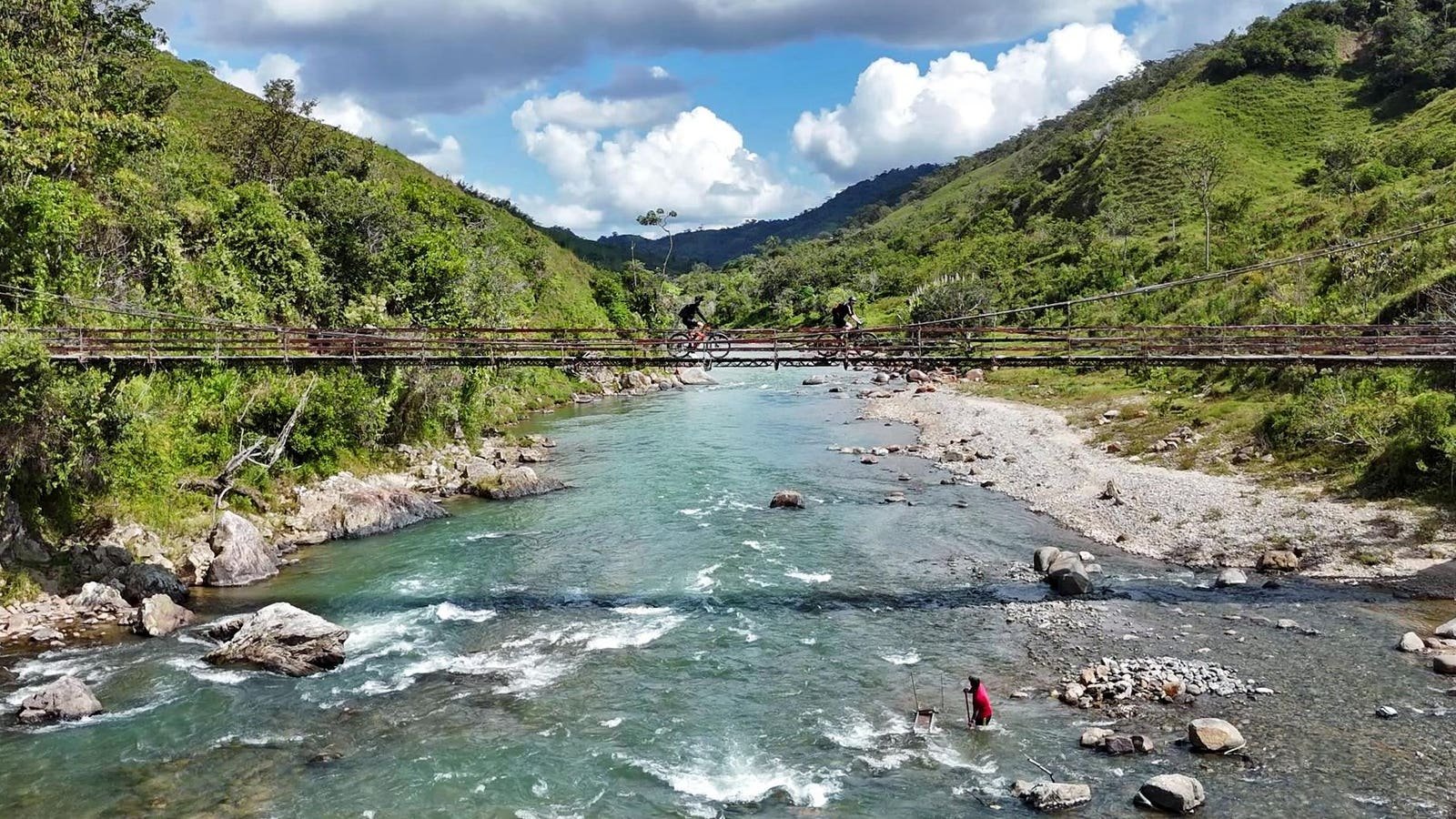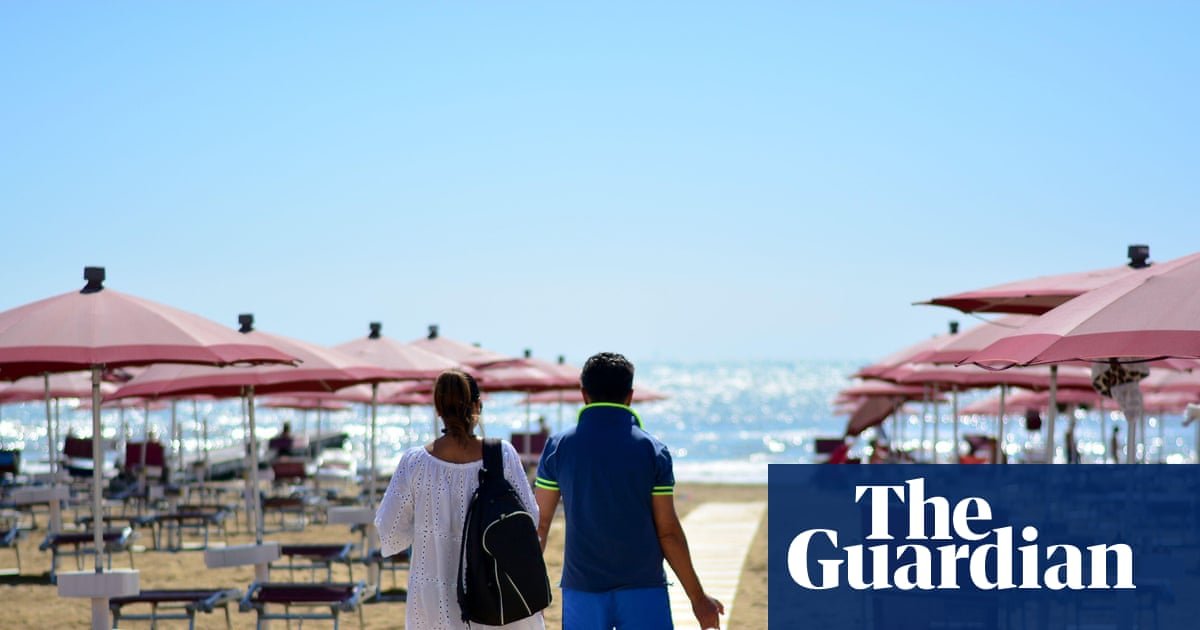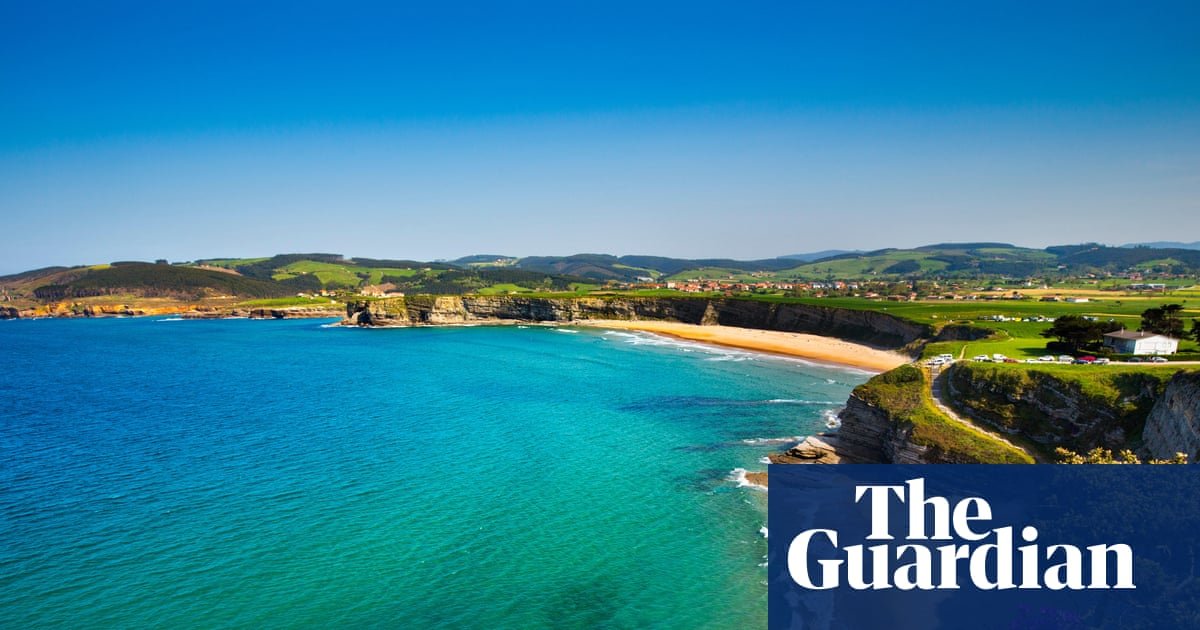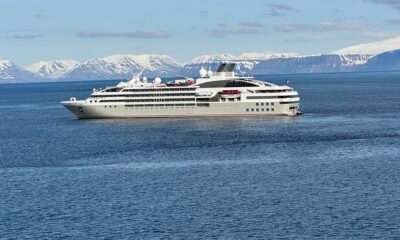Ways to Travel
This Travel Startup Is Bringing Adventure Racing To New Audiences

Cycling through the Colombian wilderness
Courtesy of Terra Venture
“You fit like a year’s worth of emotion—highs and lows—into one week,” says adventure racer Rob Preston about his chosen sport. “It’s something you can’t really explain until you’ve gone and done one.”
The downside of adventure racing—crossing wide wilderness by foot, bicycle and kayak—is that it takes years of dedicated training to get those highs and lows. Which is why Preston’s fellow racer Charles Triponez had an idea. He aims to help people go and do one without such a hefty commitment.
His new company, Terra Venture, offers the life-changing experience of adventure racing without the hardcore training, the risk or even much serious discomfort. Somewhat like the luxe-adventure travel company Black Tomato’s Get Lost initiative from a few years ago, the idea is to get people out of their comfort zone, but, you know, not too uncomfortably.
Terra Venture’s local partner, Juancho Aristizabal, on the course in Colombia
Courtesy of Terra Venture
On its landing page, Terra Venture announces, “Nothing great is accomplished while you are comfortable.” But scroll down and you see the rest: luxury hotels as bookends, expert coaching and guidance, and a fair bit of buffeting from the elements.
That’s not to downplay the challenge. Triponez, who, along with his cofounder, Roy Malone, has decades of global competition experience, explains that adventure racing is not for the faint of heart but still has a purity of purpose. It’s not dangers that are “extreme” for the sake of being extreme, but it’s making your way across vast distances, using old-fashioned navigation, finding the thrill of exploration and digging deep to find resilience.
Terra Venture is hosting three events this year on a course in Colombia’s Antioquia region. The starting point is a remote location, and the destination is up to 100 miles away. Each team journeys across land and water using their brains as well as their bodies. There’s no GPS—no technology or connection to the wider world at all—and only maps and compasses for guidance.
The idea is to do something hard and return home changed.
Rappelling on the course in Colombia
Guillermo Gutierrez
“We’re focusing on people who have achieved a lot in their life,” says Triponez. “It can be on a professional level, it can be on an athletic level, and they’re looking for the next step. Or people who want a fresh restart or an adventure—if I can say, I hate saying that—an adventure of a lifetime. These are entrepreneurs, these are C-suite people, these are weekend warriors or ex-pro athletes or pro athletes.”
He continues, “A very important aspect is that it’s not just for men. Adventure racing is probably one of the sports that, I would say, flatten out the difference between men and women.” Some of the strongest teammates he’s ever competed with are women, and now they’re some of Terra Venture’s coaches.
They and other coaches help guests prepare for the event, which is accessible to anyone with a “reasonable” level of fitness—being able to walk a half marathon, ride a bicycle for two hours straight, and paddle a kayak on flat water for an hour. The coaching helps them get there or kick it up a notch, but the course is also customized, with direct routes for some and extra distance for others, ensuring that everyone has a challenging 48 hours but also that everyone makes it.
The kayaking portion of a course
Courtesy of Terra Venture
Unlike traditional adventure racing, Terra Venture’s events are not competitions. Each participant (or small group of participants) is paired with a seasoned “teammate” who offers camaraderie but also shows how to navigate wilderness challenges and makes sure no one gets lost or injured. Other local adventure pros follow along and monitor in the background, ready to swoop in if anything goes awry. They’ve also partnered with Global Rescue for extra peace of mind.
(A side note about potential awry-ness: The company decided to lift some of the secrecy around its course to emphasize that its finish line is in Guatapé, nearly 400 miles—15 hours by car—from a conflict in the country’s northeastern tip. It also upped its security protocols to include live location sharing with participants’ close families, and added to its staff two active members of the country’s search and rescue forces, who remain in direct contact with each team for any potential urgent extraction.)
Another key distinction is that instead of roughing it and napping exposed to the elements, participants will have designated sleeping areas, either ultra-basic hotels or campsites that have been set up for safe rest. And of course, there are luxury boutique hotels and really good food on the nights before and after the main event.
Cycling through remote Colombia
Courtesy of Terra Venture
As for that event, “the course is truly a gem,” says Triponez, who made a trial run a couple of weeks ago. “It has a sweet mix of everything you can expect for such an adventure—from lively small towns with strong national history to feeling and being lost in the middle of nowhere and anything in between. Participants will also run into ‘unexpected’ historical cultural experiences along their journey.”
And even though they’ll be offline, they’ll have documented memories. Photographer Guillermo Gutierrez (who shoots competitions for the Adventure Racing World Series) will be tagging along and capturing participants as they navigate the course.
Triponez and Malone are also looking to the future. After this year’s races in the Antioquia region, they’re planning events in other parts of Colombia and beyond, tapping into their broad international network of elite adventure racers. They’ve also just signed an agreement that allows them to create a home course in the US Pacific Northwest.
“These races have taught us so much: grit, resilience, humility, respect, patience and the power of teamwork,” says Triponez. “We’re passionate about giving people a chance to discover their true potential and create unforgettable memories through adventure.”
MORE FROM FORBES
Ways to Travel
Dog Owners Urged to Check Beach Rules Before Booking Cornwall Holidays

As August reaches its peak holiday season, Park Holidays UK is urging dog owners to double-check local beach rules before booking or heading to the coast. Seasonal restrictions are now in place across many parts of the UK, with dozens of popular Cornwall beaches included.
Cornwall’s Seasonal Dog Bans
In Cornwall, restrictions typically run from July to 31st August, enforced daily from 10 am to 6 pm. Several beaches have full summer bans during this time, including:
-
Polzeath Beach
-
Porthmeor, Porthgwarra, Porthgwidden, Porthcurno
-
Porthleven West, Sennen Beach, Swanpool and Trevone
Violating these Public Spaces Protection Orders can lead to fines of up to £1,000. View our article for a full list of dog beach restrictions here.
Warnings for Other UK Holiday Destinations
Similar restrictions apply elsewhere in the UK. In East Sussex, major seaside towns such as Brighton & Hove, Eastbourne, Seaford, Hastings, and parts of Bexhill and Camber Sands have bans from 1st May to 30th September.
In Wales, Caswell Bay in Swansea enforces a ban from 1st May to 30th September, while across the UK hundreds of beaches operate seasonal restrictions during this period.
Advice from Park Holidays UK
Kelly Johnstone, Head of Brand & Content at Park Holidays UK, said:
“We understand dogs are part of the family, and nothing beats that seaside splash! But with beach dog bans active this August, it’s really important to check local rules before you book or travel. That helps avoid surprises and keeps everyone safe and welcome.
“Many of Park Holidays UK’s coastal holiday parks remain dog-friendly, often situated near beaches that are off-leash outside restricted hours, or totally accessible to dogs year-round, such as; St Osyth Beach near Seawick Holiday Park in Essex, or Pevensey Bay Beach near Pevensey Bay Holiday Park in Sussex*”
Planning Ahead for a Stress-Free Holiday
Park Holidays UK encourages dog owners to plan trips around these restrictions and recommends checking local council websites or using resources such as The Beach Guide for up-to-date rules before travelling.
This approach ensures that every member of the family – including the four-legged ones – can enjoy a safe and welcome break by the sea.
Ways to Travel
Italians turn away from private beaches amid debate over rising prices | Italy

Italians appear to be snubbing beaches this summer, amid claims they are rebelling against the high prices charged by the owners of private beach concessions.
Going to the beach and renting cabins, loungers and parasols – usually at the same location – has long been an ingrained habit of Italian summer holiday culture.
But this year’s season began with a notable fall in beachgoer numbers after private resorts along Italy’s two long stretches of coastline recorded a decrease of between 15% and 25% in June and July compared with the same period in 2024.
The problem is not so much the weekend, when beach resorts are often congested, especially those close to cities such as Rome, but during the week. Those who do go are also spending less on food and drink.
Fabrizio Licordari, the president of Assobalneari Italia, an association representing beach clubs, blamed the decline on the high cost of living and its consequences on spending power.
“Even with two salaries, many families struggle to reach the end of the month,” he told Ansa news agency. “In such circumstances, it’s natural that the first expenses to be cut are those for leisure, entertainment and holidays.”
The drop in attendance, however, also coincides with increases in the cost of private beach resorts and the growing rebellion against their dominance of Italian shorelines, which has left very little space for free beaches.
The cost of renting a sunlounger is a recurring topic of discussion, and rightly so – on average, it costs 17% more than it did four years ago, according to figures this week from the consumer group Altroconsumo. On beaches in the Lazio region, for example, it is difficult to rent two loungers and an umbrella for less than €30 (£26) a day. That rises to about €90 in the popular resort of Gallipoli in Puglia.
The actor Alessandro Gassmann stoked the debate after sharing a photo of a beach with deserted loungers on his Instagram page and writing alongside it: “I read that the season is not going well. Maybe it’s because the prices are exaggerated and the country’s economic situation is forcing Italians to choose free beaches? Lower the prices and maybe things will get better.”
after newsletter promotion
Maurizio Rustignoli, the president of Fiba, the Italian beach resorts federation, argued that reports of high price rises were “misleading” and that, where they occurred, it was by only a small percentage. He added that people in return benefited from services including security and lifeguard supervision.
But the consumers association Codacons said going to beach resorts had become “a drain” on people’s finances and accused the concession owners of “shedding crocodile tears”.
The beaches might be losing custom, but areas in the mountains, especially the Dolomites, have had a significant rise in visitor numbers, with some areas fearing overtourism. According to a report this week in the newspaper Il Messaggero, more Italians are venturing to the mountains for their holidays, partly as a way to escape increasingly hot summers caused in part by the climate crisis.
Ways to Travel
A cooler costa: the summer glories of northern Spain’s Costa Trasmiera | Spain holidays

While we all know that “costa” is simply the Spanish word for “coast”, for most of us it has a much wider meaning, evoking all sorts of images, both positive and negative. It may be beaches, fun, cold beers and tapas at a chiringuito (beach bar) with your feet in the sand. Perhaps you’re thinking of childhood holidays in a thrillingly huge hotel, where you happily stuffed yourself with ice-cream and chips for a fortnight. More recent memories might revolve around showy beach clubs with exorbitant prices. If you’ve been to the costas of eastern or southern Spain in the past few years, however, you may have reluctantly concluded that your favourite resorts are now a bit too hot for comfort.
This year, there has been a lot of buzz about “la España fresca”, or cool Spain, but, in reality, Spaniards have been thronging the northern coast in summer for decades, decamping to Galicia, Asturias, Cantabria and the Basque Country. This is particularly true for residents of Madrid and other cities in central Spain that are stifling in July and August.
Along the north coast, temperatures are usually more like those of Cornwall on a good summer’s day. But be warned: you do get blisteringly hot spells, too, not to mention a greater risk of wet weather. I have trudged along beaches in driving rain in June, but enjoyed glorious sunshine and delicious swims well into September.
One of my favourite chunks of northern Spain is the Costa Trasmiera in Cantabria. If you are trying to cut down on flying, it has the advantage of being easy to reach by Brittany Ferries from Portsmouth or Plymouth to Santander, the regional capital, or from Portsmouth to Bilbao, an hour’s drive away.
Sailing into the Bay of Santander, your eyes are drawn to the city, framed by its string of beaches, rising up on your right. Look left, however, and the view is rural rather than urban. A long spit of glittering sand, El Puntal, protrudes into the bay, with a green landscape stretching out behind it to the east. This is the Costa Trasmiera, a stretch of about 30 miles (50km) between Santander and the fishing town of Santoña.
A car is really useful to get to different beaches along the coast, but there are buses from Santander to the main places, such as Somo, Noja and Santoña. With a car, you are only likely to be travelling short distances each day, so using an EV is no problem.
If you liked the look of El Puntal as you were arriving, you can jump on a little ferry across the bay. I love doing this when I’m staying in Santander, as within a quarter of an hour I’m running into the sea, shrieking as the cold water hits my body. If you’re used to wallowing in the tepid soup of the Mediterranean in summer, it might come as a bit of a shock.
Back on the sand, a chopped seafood salad and glass of rosé at Chiringuito El Puntal Tricio always hits the spot. Walking along the beach brings you to Somo, a hub for surfers from all over the world, where you’ll find lots of cafes, bars and places offering surfing and paddleboarding tuition. Hotel Bemon Playa (doubles from €90 room-only) is in the thick of things if you fancy staying for a few days.
Heading east along the coast, it’s one superb beach after another: Loredo, Langre, Galizano, Antuerta, Cuberris. Book a table for a lobster lunch or a seafood platter overlooking the sea at Hotel Astuy (doubles from €60 room-only) in Isla, where the crustaceans served in the restaurant are kept in seawater pools in caves below the building. The hotel is a good base for exploring the area, but just beyond Isla, right next to Playa de Ris, Camping Playa Joyel (pitches from €19.50) is one of several good campsites on the Costa Trasmiera, with lots of facilities to keep kids happy.
From the campsite, it’s an easy walk into Noja, the main holiday town on the coast. Practical rather than pretty, for most of the year it is a sleepy place with a population of about 2,500. In summer, however, the number rises to an astounding 80,000-plus, mostly in second homes and holiday apartments – a much higher ratio of tourists and second-home owners to residents than in resorts on the Costa Blanca and Costa del Sol. Families from other parts of Spain, especially the adjacent Basque Country, install themselves for the entire school holidays, which can stretch from late June until the second week of September.
after newsletter promotion
Although there are vestiges in Noja of the village it once was – including the church of San Pedro on the main square and a handful of grand mansions – the streets are lined with apartment blocks, with shops, bars and restaurants at ground level. This may not be the most attractive place, but for the thousands who come here year after year, it has everything needed for a relaxing holiday with no delusions of grandeur or attempts at being cool. No one cares what you’re wearing here.
With Playa de Ris on one side of Noja and the equally gorgeous Trengandín stretching away on the other (a path links the two), it’s not hard to see how people while away a summer here with swims, picnics, leisurely walks, long lunches and sunset cocktails. Seafood is, of course, excellent, but the nécoras (velvet crabs) are particularly prized.
Those who can summon the energy to move on from Noja only have to round the El Brusco headland at the end of Trengandín to come upon yet another splendid beach. Berria is bordered by the Santoña, Victoria and Joyel marshlands, a nature reserve that attracts migratory birds from autumn to spring.
The adjacent town of Santoña marks the end of the Costa Trasmiera. It’s all about fisheries and canning factories here, which is a lot more interesting than it sounds. As long as you like anchovies, that is. Santoña anchovies are bigger and fleshier than most, with a softer texture and a more delicate flavour, and here they’re expertly filleted and preserved in olive oil. Considered a delicacy throughout Spain, they are served straight out of the tin at top restaurants and tapas bars. Have a look around the anchovy museum – really – before ordering some at a bar, along with a plate of sardines and a beer. Devour the lot while standing at a high table on the pavement outside, then quaff another beer. You may find yourself ordering more anchovies as well.
By now you should have tuned into the laid-back Costa Trasmiera vibe. All you have to do, at some point, is make your way back to Santander. It only takes about half an hour by car, but you may be tempted to stop at some of the inland villages along the way. This is not an area to rush around, which – if you’re doing things properly – you will no doubt have gathered by now.
-

 Brand Stories3 weeks ago
Brand Stories3 weeks agoBloom Hotels: A Modern Vision of Hospitality Redefining Travel
-

 Brand Stories2 weeks ago
Brand Stories2 weeks agoCheQin.ai sets a new standard for hotel booking with its AI capabilities: empowering travellers to bargain, choose the best, and book with clarity.
-

 Destinations & Things To Do3 weeks ago
Destinations & Things To Do3 weeks agoUntouched Destinations: Stunning Hidden Gems You Must Visit
-

 Destinations & Things To Do2 weeks ago
Destinations & Things To Do2 weeks agoThis Hidden Beach in India Glows at Night-But Only in One Secret Season
-

 AI in Travel3 weeks ago
AI in Travel3 weeks agoAI Travel Revolution: Must-Have Guide to the Best Experience
-

 Brand Stories1 month ago
Brand Stories1 month agoVoice AI Startup ElevenLabs Plans to Add Hubs Around the World
-

 Brand Stories4 weeks ago
Brand Stories4 weeks agoHow Elon Musk’s rogue Grok chatbot became a cautionary AI tale
-

 Brand Stories2 weeks ago
Brand Stories2 weeks agoContactless Hospitality: Why Remote Management Technology Is Key to Seamless Guest Experiences
-

 Asia Travel Pulse1 month ago
Asia Travel Pulse1 month agoLooking For Adventure In Asia? Here Are 7 Epic Destinations You Need To Experience At Least Once – Zee News
-

 AI in Travel1 month ago
AI in Travel1 month ago‘Will AI take my job?’ A trip to a Beijing fortune-telling bar to see what lies ahead | China










